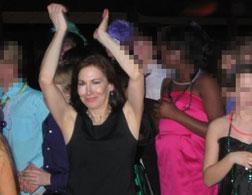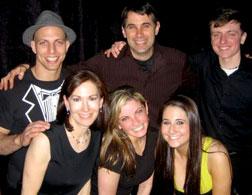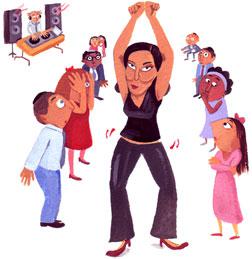I was getting ready for my gig as a “motivational dancer” at a bar mitzvah party when my daughter, who at age 14 has just completed her year on the bar and bat mitzvah circuit, decided to give me some advice. “Don’t do this,” she said, as she shook her torso in a shimmy. “And don’t do this,” she said, bouncing to the pony. “And whatever you do, don’t do this,” she said, passing her first two fingers in a V across her eyes (think John Travolta’s dance scene in Pulp Fiction). Banning my entire repertoire was necessary, she explained, “because your old-people moves are going to make everyone uncomfortable.” My dances were of such antiquity that to a group of 13-year-olds it might appear I was re-enacting rites of the Hasmoneans. They would be right that I had perfected them in ancient times—during my own bat mitzvah season 40 years ago.
But my daughter wasn’t done with me. I had been told to dress all in black, so I had on black silk pants, a black cashmere beaded top, and pearl earrings. “Mom, you cannot wear that,” she said. “Everyone’s going to think you’re the aunt. At these parties the dancers are in spandex and sneakers.” I argued that if I wore spandex and sneakers, everyone would think I was the crazy aunt who’d just gotten a day pass to attend the party. She went through my closet and found a black tank top she said was acceptable. I also prepared myself with three essentials for an evening of motivating: a dose of an anti-inflammatory, flat shoes, and earplugs. I ascribe much of my midlife hearing loss to the sonic boom bar mitzvah music of my youth.
Readers have suggested the ideas for several Human Guinea Pig columns, in which I try jobs or hobbies that often require an ability to make a fool of oneself. This idea came from a friend. I admit I bring an irrational exuberance to the dance floor, which wearies my husband and embarrasses my daughter. So it seemed natural when Washington Post columnist Ruth Marcus, at the bat mitzvah of her eldest daughter (read about it here), dragged me over to her MC, Doug Sandler, aka D.J. Doug, and told him he had to let me join his crew.
The bar mitzvah (for boys) or bat mitzvah (for girls) is the ceremony that marks a Jewish child becoming a member of the adult community. The 13-year-old stands in the synagogue and reads Hebrew from the Torah, chanting words his or her forebears have spoken for thousands of years. And that evening another event takes place just as steeped in ritual: the bar mitzvah party.
When I was 13, there were no professionals to motivate us. The adults were fueled onto the dance floor by booze, cigarettes, and mountains of cleavage. We kids eagerly rubbed against one another, creating a funk of hormones and hairspray. While bar mitzvahs can be notorious for their extravagance, the ones I’ve been to in recent years have been well-behaved affairs, featuring a band or DJ. The major addition since my time is an array of carnival-like activities, from photo booths, to wax hands, to caricaturists. D.J. Doug says parents started requesting dancers a few years ago after seeing them at parties in New York, and they are now standard at a top-flight bar mitzvah.
D.J. Doug, 45, has presided over about 1,900 bar and bat mitzvah parties in the Washington, D.C., area over the past 20 years. He is tall and rangy, looks years younger than he is, and has endless, infectious enthusiasm. He has 12,000 songs loaded on two laptops, and his assistants will play 60 in the course of a four-hour party. Doug’s out front, working the room, leading dances, overseeing games and contests, building the evening to a strobe-lit frenzy, then gradually easing off with slow-dancing so that everyone is spent and sated by the end.
Doug’s starting fee is $3,000—and if you want him, he’s got some dates available in 2013. The costs go up with à la carte additions such as dancers, who make, depending on experience, $75 to $300 a night. Our job was to get people out of their seats, lead the line dances, and hand out novelties. But it was more than that. Doug explained the dancers are supposed to “create an instant party” and be “that spot of excitement that people just gravitate to.”
This would be trickier for me than his other dancers, who range in age from the late teens through the 20s, making them like older siblings to the kids. I was like someone who could have given birth to the kids. I planned to stay far enough away from the teenage boys that I didn’t stymie their normal sexual development. But I also had to be careful not to get any grandfathers boogying so hard that they collapsed with angina. (One of the worst experiences of D.J. Doug’s career was when the bar mitzvah boy’s uncle was felled on the dance floor by a heart attack.)

For an apprenticeship, Doug invited me to a bar mitzvah party held in a downtown Washington building. I was appalled to discover it was a children’s-only affair—this meant no Motown, no Aretha, no music I knew how to dance to. Even worse was the fact that about a dozen of the celebrants were children of friends; a few did double takes and asked what I was doing there. I ended up slinking around the DJ stand studying 21st-century music and moves. I needed to clap my hands over my head, bend my elbows and circle my fists in the air, and thrust my hips sharply as if signaling the directions on a compass.
There were three dancers that evening, a break-dancing guy and two young women whose advice I solicited. An adorable, petite 20-year-old said an occupational hazard is being air humped by pubescent boys—think of a Labrador retriever attaching itself to your leg—whom she good-naturedly shakes off. I was certain I wouldn’t have to deal with this problem.
I was amazed how, upon hearing the first notes of a song, the kids instantaneously formed lines and perfectly executed complicated steps in unison, like a scene out of Glee. They all knew every shake of Beyoncé’s “Single Ladies (Put a Ring on It).” At one point the daughter of a friend took pity on me and invited me to join the line dance to Miley Cyrus’ catchy “Party in the USA.” It was a sweet gesture, but it turned out she had an ulterior motive. I’m friends with her parents, her bat mitzvah was the following Saturday, and she begged me not to ruin it by showing up as a fly girl.
If I was ever going to be able to uninhibitedly motivate, I would have to get clear of kids that I knew and go on an out-of-town date with Doug. A few weeks later, he took me to a bar mitzvah near Annapolis, Md. The party was scheduled from 6:30 p.m. to 10:30 p.m., but Doug always arrives an hour early for setup. Again there were three other dancers. Steven Golob, 29, a high-school science teacher who moonlights as a break dancer, and two college students, Rachael Topel, 18, who has been at this for two years, and Brittani Kaltman, 19, who was on her second bar mitzvah gig.
In the quiet before the guests arrived, we unpacked a crate of novelties: plastic necklaces and hats, costume sunglasses, fake guitars, light sticks. I came to think of it as the big box of dreck, D.J. Doug’s piece of the trade deficit with China. When the party begins at 6:30, Doug sets a mood of what he calls “organized chaos” for the kids and allows the adults to forget their parental duties and have a few drinks.

We motivators handed out necklaces and sunglasses, then there were a series of quick games: a hula-hoop contest, a scavenger hunt. This was followed by the first line dance, “The Cupid Shuffle” by Cupid. I had heard of neither Cupid nor his shuffle, but I liked the song and appreciated that the lyrics were the dance instructions. I tried not to look too conspicuous as I led a dance the kids knew better than I did.
When I glanced over at the adults at the bar on the other side of the room, I felt a deep longing to stop being ridiculous, get a glass of cabernet, and join a discussion about how health care reform would affect the midterm elections. Suddenly I saw by the bar a friend of mine, Iris Krasnow, a journalism professor at American University who’s had me speak to her classes for several years. Since I was trying to stay incognito, I wondered if I should avoid her or say hello. My dilemma was solved when she came up to me and said, “Wait until Doug starts playing Motown and the adults show the kids how to dance!”
After the cocktail hour, we motivators were on the sidelines for the video montage of the bar mitzvah boy’s life, followed by dinner. At 8:30 p.m., Doug blessedly put on “Respect,” the adults and kids poured onto the dance floor, and I joined the adults who jiggled with abandon. I danced with a 10-year-old girl whose parents encouraged her to copy my moves, and then boogied with two older women. Iris came over to me and we shimmied (yes!) to each other. Afterward I asked her how she knew the family, and she looked at me with her mouth hanging open. It turned out that my showing up as a fly girl fritzed out Iris’ ability to recognize me. “Oh, my God, I knew your face was familiar, but I just thought I’d seen you dancing at other bar mitzvahs!” she said.
With the adults now on the dance floor, the kids responded defensively. In the book Millions of Monarchs, Bunches of Bees: How Bugs Find Strength in Numbers, entomologist Gilbert Waldbauer describes how leaf beetle larvae form a tight circle with their heads facing inward and their tails thrashing to scare off their primary enemy, the stinkbug. I knew I was a stinkbug, so I left it to Rachael and Brittani to try to interact with the little larvae. I ponied across the floor and acted as if the adult couples wanted me to dance with them. A few guests commented on my efforts. “You have such spirit,” said one, which I took to mean, “You’re embarrassing yourself.” Another said, “You have so much energy,” kindly leaving off “for someone your age.”

At 10 p.m. Doug played the first slow dance, this generation’s standard, “You’re Beautiful”by James Blunt, which is far inferior to my generation’s “Cherish” by the Association. One thing that hasn’t changed in the past four decades is 13-year-old slow dancing. The brave couple comes onto the floor, he puts his hands on her waist, she puts hers on his shoulders, and they sway gingerly as if trying to steady a balance board. Looking at them, I remembered the time Alex Wirkerman asked me to dance to “Cherish.” I was wearing a pink and orange striped dress, and when Alex put his hands on my waist a tingle went up my spine and I felt I had crossed some mysterious threshold.
My reverie was interrupted by the limbo. Then all the motivators helped Doug lead another line dance to “Thriller.” And I have been to enough of D.J. Doug’s bar mitzvah parties to know that when he puts on Journey’s “Don’t Stop Believing,” the party’s almost over.
Although I didn’t get home until 1:15 a.m, I felt exhilarated. It was as if I’d been released from a bomb shelter I’d crawled into in 1968. Thanks to D.J. Doug I learned young person moves to young person songs—I love you, Taylor Swift! And even if I wear cashmere and pearls to the next bat mitzvah we’re invited to, maybe my daughter will finally dance with me.
